Tom's Guide Verdict
The LG G1 OLED TV is the first set with OLED evo, a new technology promising an elevated viewing experience. While it falls short of some performance expectations, a lower price, better remote and same flush-mount design still make this Gallery Series set an attractive option.
Pros
- +
Exclusive OLED evo panel delivers brighter picture
- +
More affordable than last year’s Gallery Series
- +
Same stunningly-thin design
- +
Great gamer-friendly upgrades
- +
New remote is a major improvement
Cons
- -
OLED evo offers minimal improvement
- -
WebOS 6.0 is disappointing
Why you can trust Tom's Guide
Price: $2,299
Model number: OLED65G1
Screen size: 65 inches
Resolution: 3840 x 2160
HDR: Dolby Vision IQ, HDR10, and HLG
Refresh rate: 120 Hz
Ports: 4 HDMI 2.1; 3 USB
Audio: 60 watts (20-watt woofer)
Smart TV software: webOS 6
Size: 56.9 x 32.7 x 0.9 inches (w/o stand)
Weight: 63.9 pounds (w/o stand)
Although OLED technology already offered the best TV performance around, LG looked to elevate its lineup’s standards this year. The LG G1 OLED TV features an all-new panel called ‘evo,’ advertising a brighter image and better color range than existing OLED screens.
Compared to the LG GX OLED TV, one of the sleekest sets I reviewed last year, the G1’s upgrades feel more exclusive. Rather than outfit the same panel in its top and second-tier sets, LG reserved evo for its ultra-thin Gallery Series. (That combination won it a 2021 Tom's Guide Award for best TV design!) You’ll get the latest webOS version, redesigned remote and Gen 4 a9 processor on all the LG 2021 TVs, a flush-mount design is no longer the only thing the G series holds over the rest.
Better yet, the 65-inch model I tested for this LG G1 OLED TV review costs $500 less than the 65-inch LG GX OLED did when it first came out. It's the best 4K TVs LG makes right now, and one of the best OLED TVs on the market. But is the promise of a lower price for a more advanced panel too good to be true? Let’s find out.
LG G1 OLED TV review: Price and configurations
The LG G1 is the standout set of the company's line of OLED TVs. The C1 series might be more affordable, but it doesn’t offer the same super-slim chassis and evo panel of G1 models. The C1 doesn’t get far-field mics or a NextGen TV tuner, either.
Those notable premiums come at a slightly premium price — the LG G1 is the most expensive set we’ve tested this year, although it’s less expensive than the LG GX was at launch. The 65-inch configuration costs $2999, while the smaller version model costs $2199 and larger 77-inch size costs $4499.
While you can find last year’s LG GX on sale right now with some of the best cheap TV deals, the G1 won’t see discounts until we approach the holiday season. When that time does roll around, though, make sure to check our LG promo codes page to see if we can save you on the usual price. And if our ‘What size TV should you buy?’ guide suggests you’ll need a TV larger than 77 inches, check out our list of the best 85-inch TVs right now. The C1 comes in a 82-inch version, too.
You should expect to see similar performance compared to our 65-inch test model. All three sizes offer evo, the latest webOS overhaul, both major voice assistants and the newest Gen 4 a9 processor.
Get instant access to breaking news, the hottest reviews, great deals and helpful tips.
LG G1 OLED TV review: Design
For those who have seen LG's Wallpaper TV, you’ll recognize the LG G1 manifests many of the same design sensibilities. The 20-millimeter-deep body accommodates everything the TV needs, including sound. Most OLED TVs feature a thin display with a protruding component box on the back, but the G1 instead has an uniform thickness featuring a recessed mount and input panels for concealing cables.

Like the Gallery Series sets before it, the LG G1 isn’t designed to rest on a stand or hang on the wall with a VESA mounting bracket. It’s supposed to be mounted with the company’s proprietary bracket, which comes in the box. (For any other set, you'd need one of the bulky options from the best TV mounts.)
We had to request a pair of L-shaped feet for testing (which normally cost $100,) but they detract from the TV’s flush-mount effect, so you should plan to hang the G1.
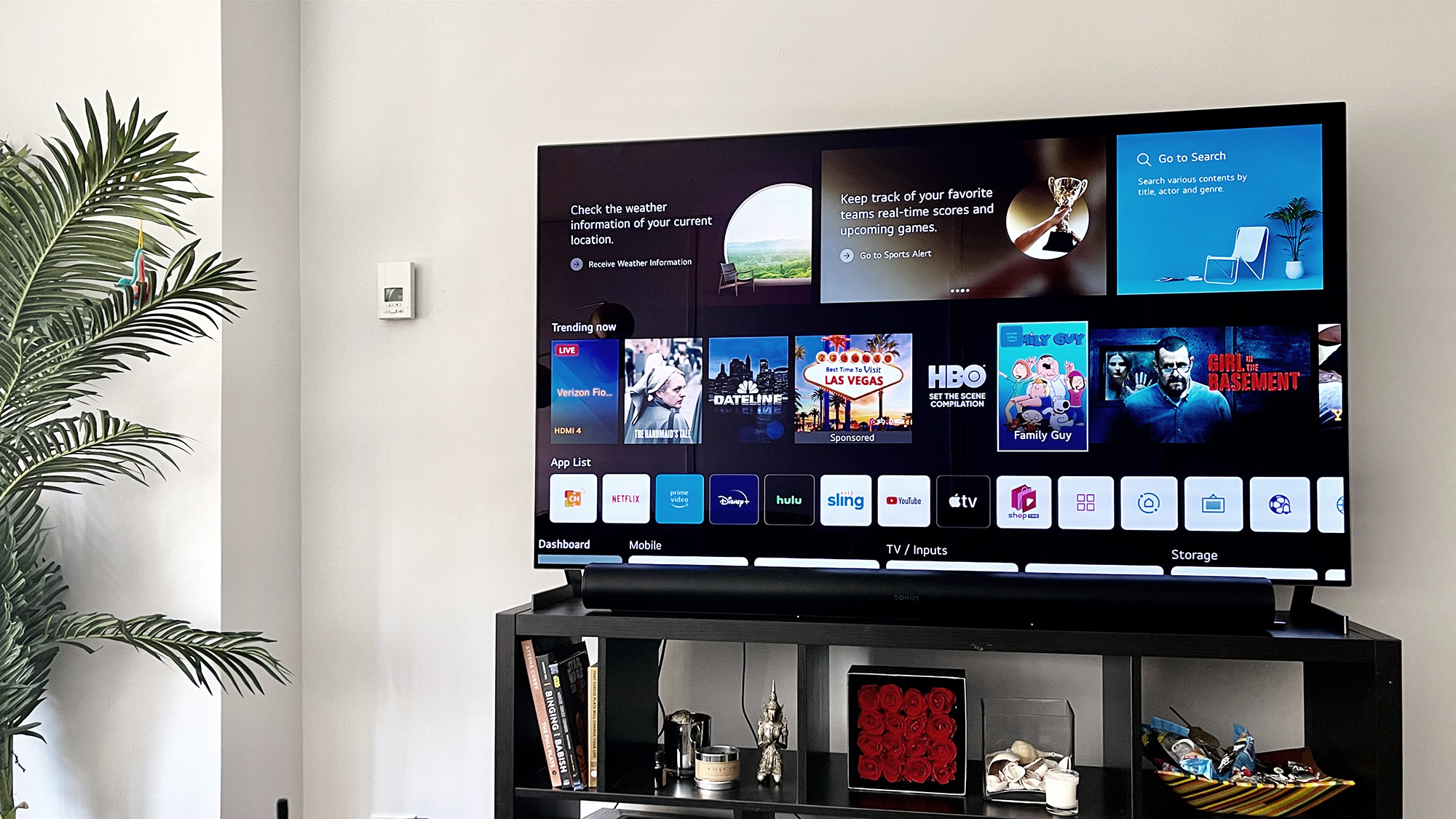
LG also recommends professional installation with a recessed AV box for the full Gallery Series effect. Or, the company sells a special easel-like stand for making your TV look like it belongs in a museum.
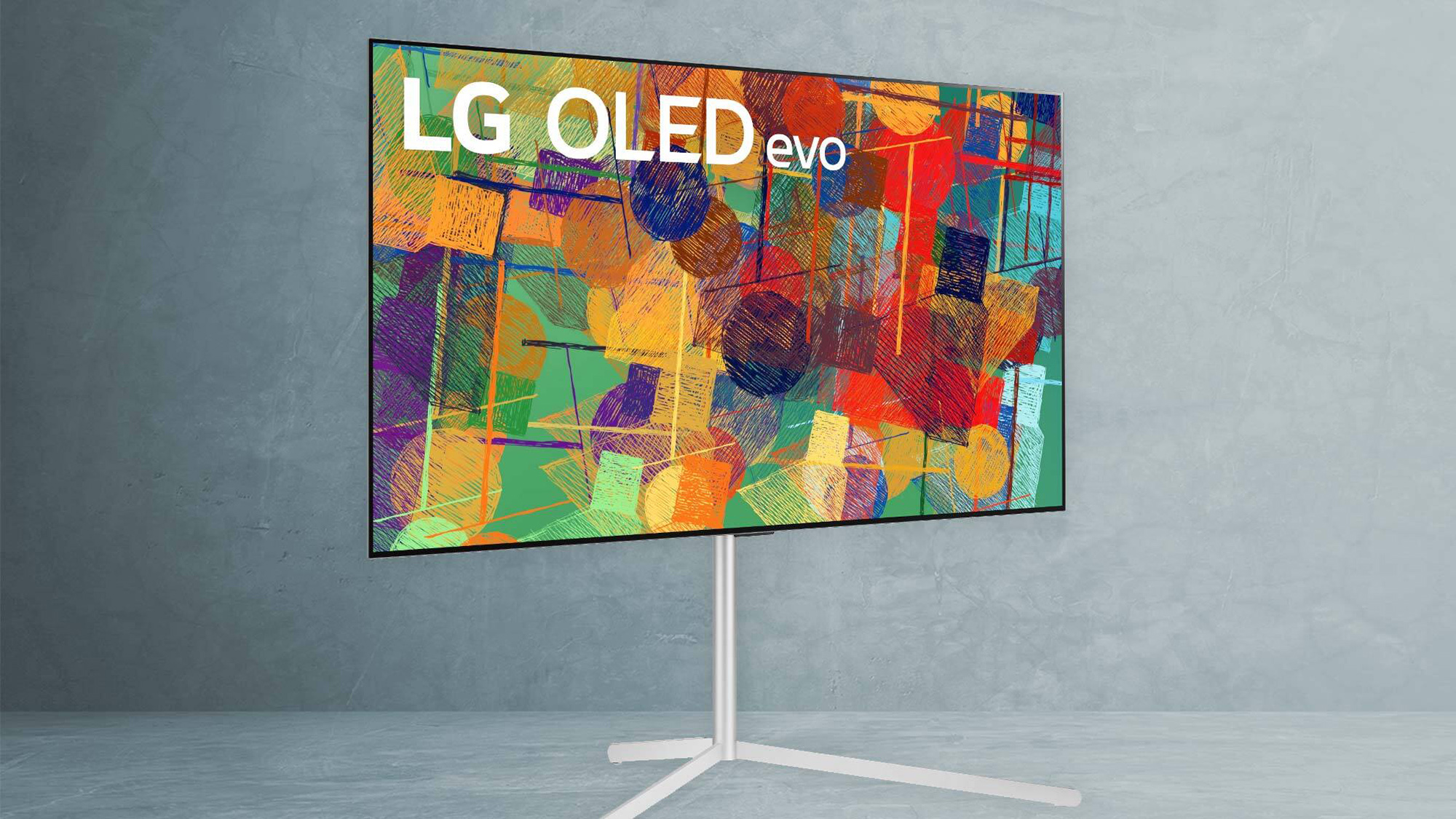
Although the stand provides cable management, I can't imagine it being very practical for your peripherals. But if you like a sophisticated and minimalist look, you might want to consider the easel.
LG G1 OLED TV review: Ports
Like all of LG’s latest OLED TVs, each of the G1’s HDMI ports are outfitted with HDMI 2.1. In addition to frame rates of up to 120Hz with 4K video and an enhanced audio return channel (eARC), HDMI 2.1 supports variable refresh rate and auto low latency mode. These settings take advantage of the next-gen graphic abilities of the PS5 and Xbox Series X. The LG G1 supports NVIDIA G-sync and AMD FreeSync, too.
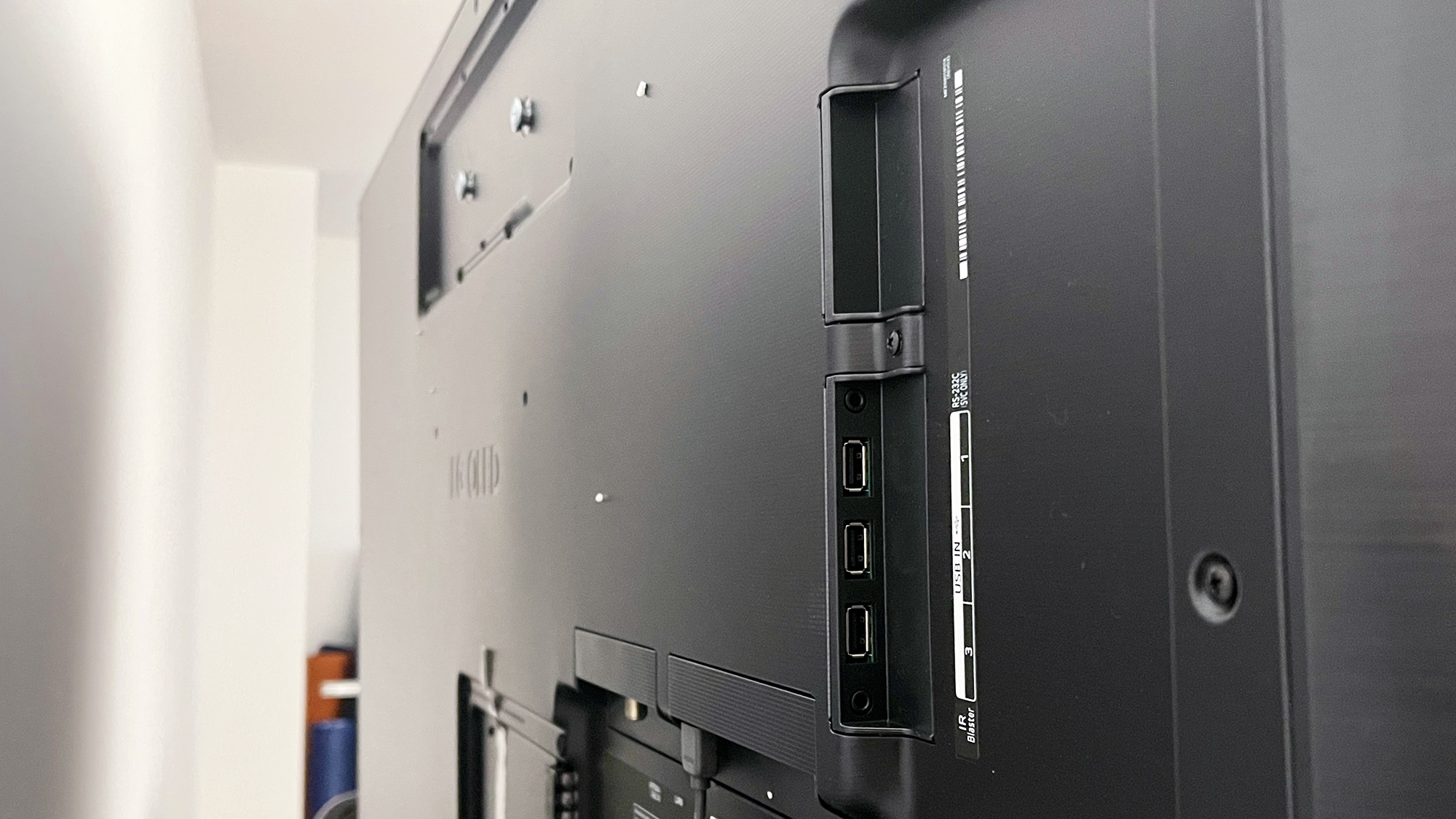
There are four total HDMI ports, which is one more than the LG GX offered. Additional connections include 3 USB 2.0 ports, one ethernet port, a 3.5mm headphone output and a RF coaxial plug for cordcutters.
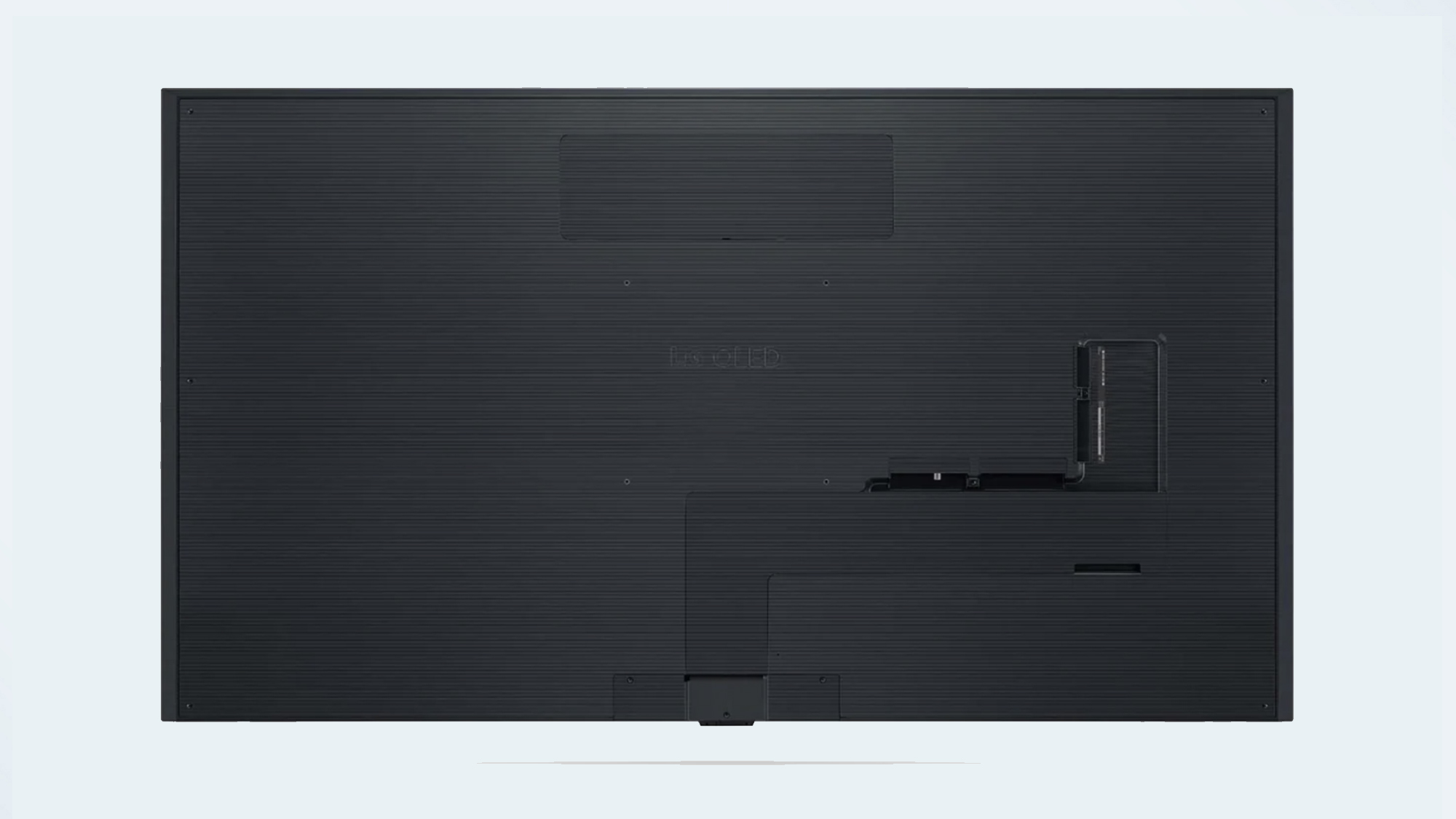
The Gallery Series OLED TVs also come with built-in NextGen TV ATSC 3.0 tuners. In the cities where the broadcasting technology is available, ATSC 3.0 provides 4K picture over-the-air and a return channel that allows for interactivity and targeted advertising.
LG G1 OLED TV review: Performance
The LG G1 OLED TV with evo supports most HDR viewing formats including HDR10, HLG, Dolby Vision. It also offers two newer formats: Filmmaker Mode and Dolby Vision IQ. Filmmaker Mode is a picture preset that is supposed to reproduce the picture as the movie maker intended. Dolby Vision IQ is essentially Dolby Vision but automatically adjusts the brightness and dynamic range with respect to ambient light in the room.
Since I tested the LG GX recently, I distinctly remember fretting over how the brightness would hold up in rooms lit by window light. From what I experienced in anecdotal viewing, the evo panel might have alleviated my worries. I once again watched the war movie Greyhound, which is filled with ominous, low-light scenes out in the ocean and lots of little variations of black hues. The GX struggled with those subtle differences, but the G1 handled the crisp details of Tom Hanks' captain uniform and the crashing waters masterfully.

There wasn’t much room for improvement in motion handling. As a torpedo sailed towards the Greyhound ship, the G1 helped build razor-sharp suspense beneath the ocean’s wake. I could see precisely how the torpedo ricocheted off Greyhound’s hull, saving the exhausted crew from an enemy U-Boat attack.
For some lighter viewing, I turned on Spider-Man: Into the Spiderverse. This movie is known for its comic-book-worthy colors, and on the G1 they didn’t disappoint. As Peter B. Parker, Miles Morales and Spider-Woman Gwen Stacey used their web-shooters to swing away from Doctor Octopus’s laboratory, the warm autumn foliage surrounding them looked artistic rather than childish. The shades of red, yellow and orange kaleidoscoped together without one overpowering the rest.
LG G1 OLED TV review: Test results
Our proprietary Tom’s Guide TV testing results didn’t completely back up what I saw in hours of watching. We even retested the set to be sure. The results are only slightly better than LG GX OLED TV’s, which is good and bad. It’s encouraging to see LG’s processor offer a degree of annual improvement, but I wonder whether the evo panel is as much of an improvement as the company advertised.
Like the LG GX, color accuracy is a highlight of the G1. It earned a Delta-E score of 1.64. Any result of 2.0 or lower is good with the lower scores being better. It’s a slight improvement over the GX (1.73) and better than the Samsung QN90A with Neo QLED (2.57).

The LG G1 also provided one the widest color gamuts we’ve ever seen, producing 133.92 percent of the Rec 709 color space, exceeding the basic color standard by a significant margin. Only the LG GX’s score was superior, producing 134.42 percent. The Samsung QN90A produced just 99.78 percent, for comparison.
Testing brightness on the LG G1 proved more complicated. Out of the box, its max brightness was less than the GX’s max brightness, contradicting the promises of OLED evo. Luckily, when we turned off the default energy saving mode, the G1 reached a max brightness of 412.05 nits, which isn’t all that much better than the GX (388.88) but great by OLED standards. It's not only the brightest and best LG TV, it's one of the best OLED TVs ever made. When it comes to brightness, though, Samsung’s Neo QLED is the new industry leader. The QN90A reached 1813.83 nits.
Lastly, when it comes to lag, the LG G1 is among the best-in-class. Thanks to its auto low latency mode, it measured a lag time of just 12.5 milliseconds. That's an improvement over results we have seen from other top sets, including the LG GX (14.9 milliseconds) and about even with the QN90A (12.6 milliseconds). This makes the LG G1 one of the best gaming TVs you can buy, especially if you want the luxurious design.
LG G1 OLED TV review: Audio
Besides the evo panel, another upgrade you’ll get with Gallery Series TVs compared to the LG C Series is boosted sound performance. Since the speakers can be distributed throughout the chassis, the LG G1 has stronger 60-watt speakers versus the C1’s 40-watt array.
Other audio improvements come from the α9 Gen 4 AI Processor 4K, which uses AI for creating more immersive audio soundscapes by better recognizing the kind of audio content playing. In addition, AI Acoustic Tuning uses the remote control's microphone to calibrate the sound and tailor the audio to your particular room.
The LG G1 OLED also supports Dolby Atmos, which designed an immersive soundscape for both Greyhound and Spider-Man: Into the Spiderverse. Even in the chaotic command room and bickering among the various spider-people (and pigs,) individual voices sounded precise.
I also tested the LG G1 with the Sonos Arc soundbar. It’s one of the best soundbars around, so it definitely elevated the listening experience. You won’t be disappointed by the built-in hardware and AI abilities, but a high-end soundbar is never a bad investment, especially for larger spaces.
LG G1 OLED TV review: webOS 6.0 and smart home features
All LG 2021 TVs ship with webOS 6.0, a redesigned interface that looks nothing like the platform has in the past. Say “so long” to the launcher bar and bottom menu tiles — now, all content is navigated on a rather bland whole-screen home page. Not only is it cluttered, but you need to stop what you’re watching to search for anything. You can adjust settings easily without interrupting your show, though.
New to settings entirely is the Game Optimizer. Game Optimizer gathers all the necessary gaming settings in a single interface, so you can easily tweak options on a game-to-game basis. LG TVs were already great for gaming, but this dedicated settings menu sets a gamer-friendly standard that I believe more TV makers will follow in the age of next-gen console obsession.
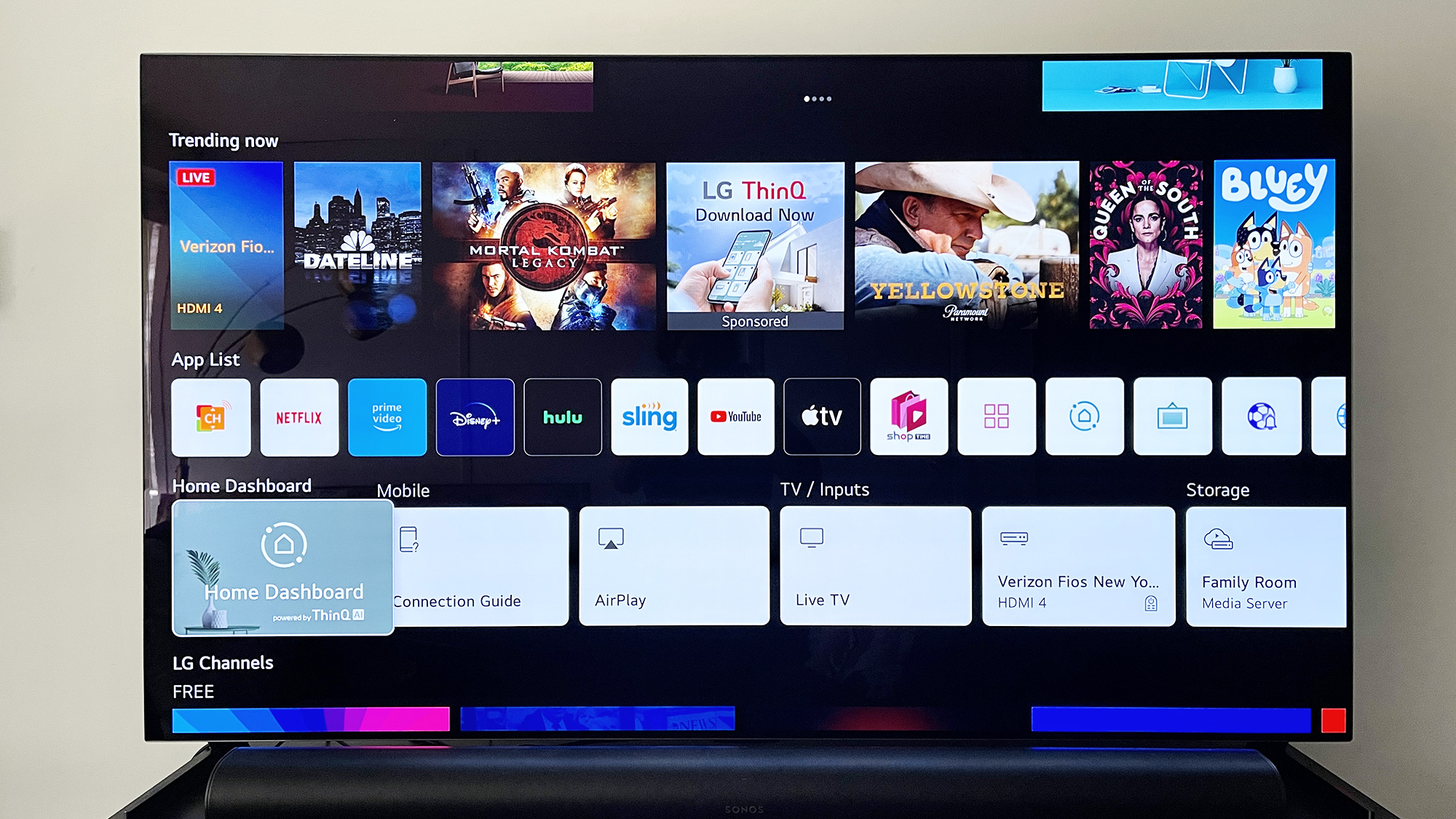
While webOS doesn’t offer quite the same expanse of apps as Roku or Android TVs, you’ll be able to watch every Marvel movie on Disney Plus, all the best Netflix shows and more. You can keep up with your favorite streamers on Twitch, too. While I still wish the Content Store offered more sports apps, it has an awesome built-in Apple TV app, so you can watch your content you’ve purchased or workout with Apple Fitness Plus without needing a separate Apple TV streaming box.
Beyond streaming and gaming content, LG ThinQ’s smart home platform gets its own dashboard on the G1 that can be used to manage anything from your Blu-ray player and soundbar to your LG InstaView fridge and other best smart home devices. You can dim your connected smart lights before watching a movie without having to grab your phone or get up from the couch. You can also pair your smart robot vacuum, and tell it to start cleaning before your guests come over.
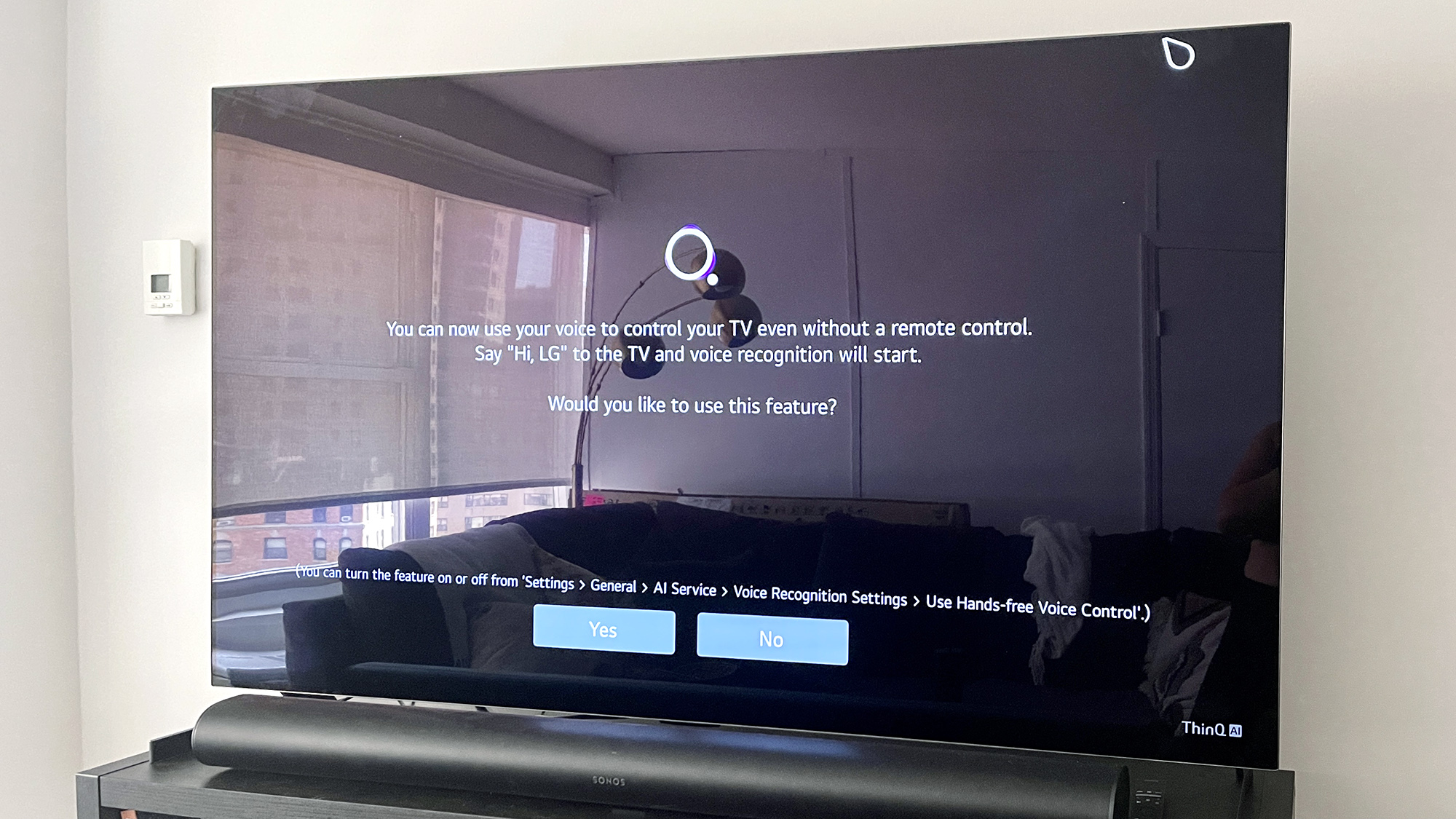
The LG G1 also has both Alexa and Google Assistant built-in, so you can use your TV to field queries as you would any of the best smart speakers. Most smart TVs are compatible with at least one of these AI butlers, but few let you beckon them just using the remote. Even fewer offer far-field mics, like the G1. Optional to set up, the set’s voice recognition feature lets you say “Hey LG” to change the channel, pause your show or find new content to watch. It basically turns the TV into a smart speaker without needing the remote in-hand.
LG G1 OLED TV review: Remote
One of my favorite upgrades from the previous year’s LG TVs is the new remote. I wasn’t a fan of the texturerd plastic and crowded button array in the past, but for 2021 LG simplified overall the shape and streamlined some of the controls. Now there are volume and channel rockers instead of individual tuning buttons. Most of the buttons are round instead of oval, too. Even with the same wireless cursor that reminds me of using a Nintendo Wii remote, it looks more modern.
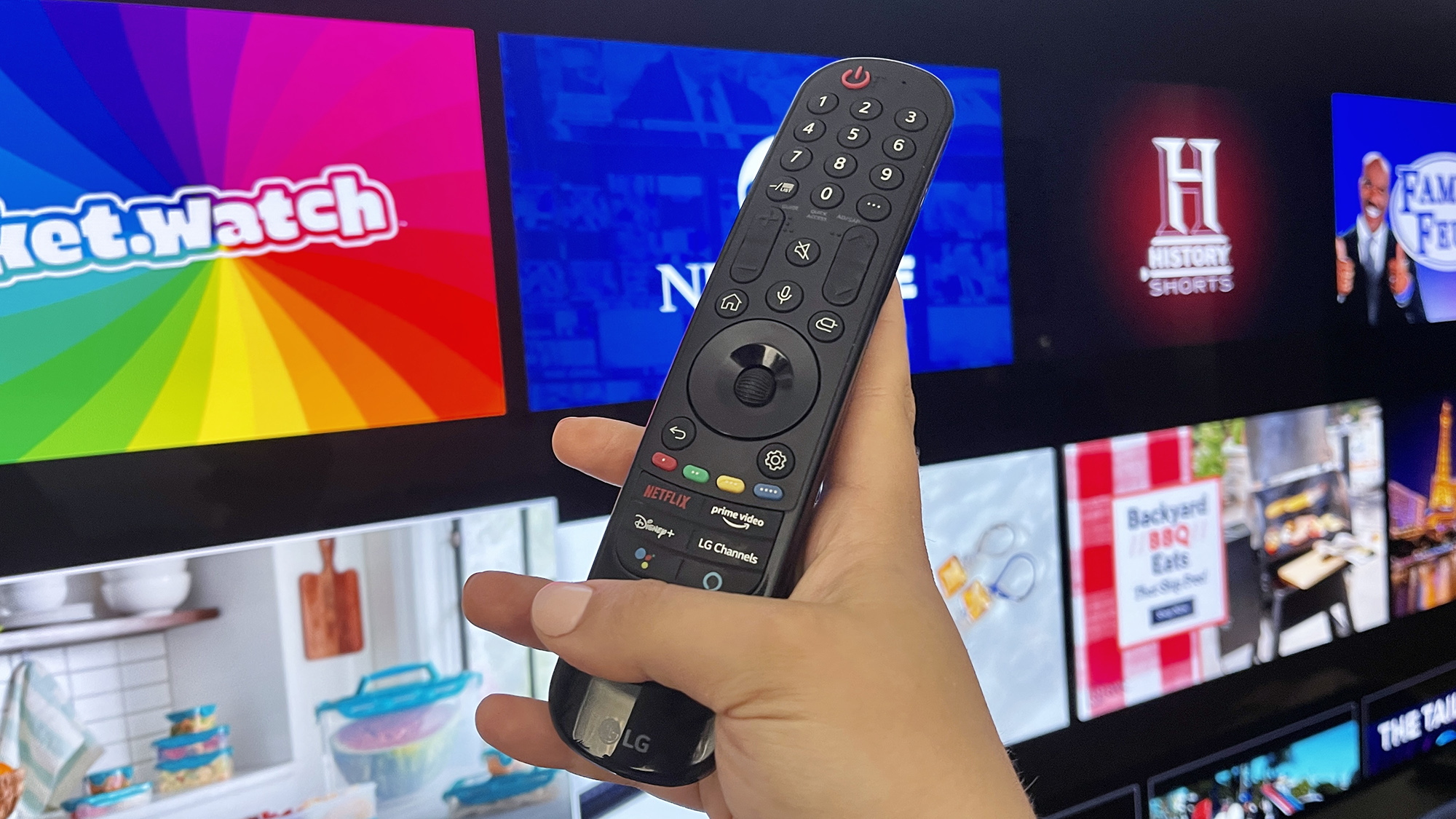
There are also more dedicated launchers than before, including ones for Alexa and Google Assistant. If you watch Netflix, Amazon Prime Video or Disney Plus often, the LG G1 OLED remote makes it easy to jump right into your favorite content.
LG G1 OLED TV review: Verdict
I wanted to celebrate the LG G1 OLED TV and its evo-lution, and before I analyzed our test results, I did. But the numbers don’t lie — OLED evo isn’t innovative as advertised. It performs more like an annual refresh, offering slight upgrades across the board. Which is still saying a lot, since the Gallery Series is among the best we’ve ever tested.
The anecdotal brightness improvement is welcomed, but there are other elements that instead make the LG G1 truly better than the GX before it. The Game Optimizer menu and improved lag time are great for gamers, while the redesigned remote and ThinQ smart home features are among the best you’ll find in the TV category.
Then, of course, there’s the super-slim, museum-worthy design. Even though I’ve seen the Gallery Series in action before, its impossibly-thin build leaves a lasting impression every time I catch a glance from the side. The LG G1 OLED TV stands as a reminder of just how far modern TV technology has come — I just hope it hasn’t plateaued.

Kate Kozuch is the managing editor of social and video at Tom’s Guide. She writes about smartwatches, TVs, audio devices, and some cooking appliances, too. Kate appears on Fox News to talk tech trends and runs the Tom's Guide TikTok account, which you should be following if you don't already. When she’s not filming tech videos, you can find her taking up a new sport, mastering the NYT Crossword or channeling her inner celebrity chef.


